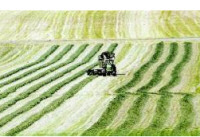



Fodder Scarcity May Affect Livestock Health
INDIA - Livestock is at the heart of rural economy, and according to the latest Economic Survey, accounts for nearly 5% of the country’s gross domestic product
Decreasing area under grasslands, combined with an increasing diversion of crop resdiues for fuel and industrial uses, is creating an acute scarcity of fodder supply for India’s livestock.
Non-availability of quality fodder in sufficient quantities, in the medium to long term, could negatively affect the health of livestock and, consequently, the production of dairy and poultry products such as milk, eggs and meat, say some experts.
“Based on our field surveys and observation, we’ve seen villagers choosing to use crop residues, such as wheat and rice straw, as fuel wood, instead of diverting it to fodder,” says M.M. Roy, senior scientist at the Indian Grassland and Fodder Research Institute, Jhansi, an autonomous body of the Indian Council for Agricultural Research (Icar).
Roy, together with another colleague K.A. Singh have written in a recent research paper project. “Huge deficit on the supply front, especially in green fodder, is anticipated,” Roy said.
Livestock is at the heart of rural economy, and according to the latest Economic Survey, accounts for nearly 5% of the country’s gross domestic product. Non-availability of good quality fodder, primary source of sustenance to farm animals, could impact their health. The researchers’ estimates indicate that the supply of green fodder in 2003—when statistics were last released—was 389.81 million tonnes (mt), while the demand was 1025mt, a staggering 61.96% deficit.








